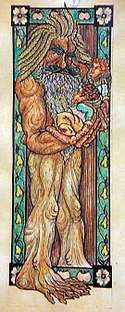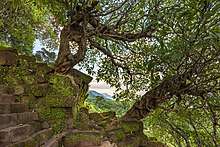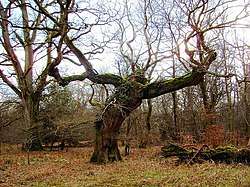Ent
Ents are a race of beings in J. R. R. Tolkien's fantasy world Middle-earth who closely resemble trees. They are similar to the talking trees in folklore around the world. Their name is derived from the Old English word for giant.
| Ents | |
|---|---|
 | |
| Also known as | Onodrim, Shepherds of the Trees, Tree-folk |
| Information | |
| Created date | First Age |
| Home world | Middle-earth |
| Base of operations | Fangorn Forest |
| Language | Entish |
| Leader | Treebeard |
The Ents appear in The Lord of the Rings as ancient shepherds of the forest and allies of the free peoples of Middle-earth during the War of the Ring. The Ent who figures most prominently in the book is Treebeard, who (credibly) claims to be the oldest creature in Middle-earth. At the time The Lord of the Rings takes place, there are no young Ents (Entings) because the Entwives (female Ents) were lost. The Ents are akin to Huorns, whom Treebeard describes as a transitional form of trees which become animated or, conversely, as Ents who grow more "treelike" over time.[T 1]
Inspired by Tolkien and similar traditions, animated or anthropomorphic tree creatures appear in a variety of media and works of fantasy.
Etymology
The word "Ent" was taken from the Old English ent or eoten, meaning "giant". Tolkien borrowed the word from a phrase in the Anglo-Saxon poems The Ruin and Maxims II, orþanc enta geweorc ("cunning work of giants"),[1] which describes Roman ruins.[T 2][2]
In Sindarin, one of Tolkien's invented Elvish languages, the word for Ent is Onod (plural Enyd). Sindarin Onodrim refers to the Ents as a race.[T 3]
Description
Treebeard, called by Gandalf the oldest living Ent and the oldest living thing that walks in Middle-earth,[T 4] is described as being around 14 feet (4 m) tall:[T 5]
[A] large Man-like, almost Troll-like, figure, at least fourteen foot high, very sturdy, with a tall head, and hardly any neck. Whether it was clad in stuff like green and grey bark, or whether that was its hide, was difficult to say. At any rate the arms, at a short distance from the trunk, were not wrinkled, but covered with a brown smooth skin. The large feet had seven toes each. The lower part of the long face was covered with a sweeping grey beard, bushy, almost twiggy at the roots, thin and mossy at the ends. But at the moment the hobbits noted little but the eyes. These deep eyes were now surveying them, slow and solemn, but very penetrating.[T 5]
Ents are an old race that appeared in Middle-earth when the Dwarves did. They were apparently created by Eru Ilúvatar at the behest of Yavanna: when she learned of Aulë's children, the Dwarves, she foresaw that they would fell trees, and desired creatures to serve as Shepherds of the Trees to protect the forests from Dwarves and other perils. Although the Ents were sentient beings from the time of their awakening, they did not know how to speak until the Elves taught them. Treebeard said that the Elves "cured us of dumbness", calling that a great gift that could not be forgotten. ("They always wished to talk to everything, the old Elves did.") In the Third Age of Middle-earth, the forest of Fangorn was the only place still inhabited by Ents.[T 5]
Ents vary widely in personal traits (height, heft, colouring, even the number of digits), having come to resemble somewhat the specific types of trees that they shepherded. Quickbeam, for example, guarded rowan trees and bore some resemblance to rowans: tall and slender, smooth-skinned, with ruddy lips and grey-green hair. Some Ents, such as Treebeard, were like[T 5]
beech-trees or oaks. But there were other kinds. Some recalled the chestnut: brown-skinned Ents with large splayfingered hands, and short thick legs. Some recalled the ash: tall straight grey Ents with many-fingered hands and long legs; some the fir (the tallest Ents), and others the birch, ... and the linden.[T 5]

Ents share some of the strengths and weaknesses of trees. Their skin is extraordinarily tough, and very much like wood; they can erode stone extremely rapidly, in the manner of tree roots, but they are vulnerable to fire and chopping blows from axes. Ents are an extremely patient and cautious race, with a sense of time more suited to trees than to short-lived mortals. For example, in the Entmoot regarding the attack on Isengard, some of them considered their three-day deliberation to be "hasty".[T 5]
Ents are tall and very strong, capable of tearing apart rock and stone (though they use their full strength only when they are "roused"). Tolkien describes them as tossing great slabs of stone about, and ripping down the walls of Isengard "like bread-crust".[T 1] Treebeard boasted of their strength to Merry and Pippin; he said that Ents were much more powerful than Trolls, which Morgoth made in the First Age in mockery of Ents. The book further lays out the power of Ents; their bark-like skin and flesh make them difficult to harm even with axes, and a single punch from an Ent can kill; although they do hurl stones, they use no other weapons.[T 5]
Tolkien has Treebeard say that "Trolls are only counterfeits, made by the Enemy in the Great Darkness, in mockery of Ents, as orcs were of elves".[3]
Internal history
First Age
Almost nothing is known of the early history of the Ents. After the Dwarves were put to sleep by Eru to await the coming of the Elves, the Vala Aulë told his wife Yavanna, "the lover of all things that grow in the earth,"[T 6] of the Dwarves. She replied, "They will delve in the earth, and the things that grow and live upon the earth they will not heed. Many a tree shall feel the bite of their iron without pity."[T 7] She went to Manwë and appealed to him to protect the trees, and they realized that Ents, too, were part of the Song of Creation. Yavanna then warned Aulë, "Now let thy children beware! For there shall walk a power in the forests whose wrath they will arouse at their peril." The Ents are called "the Shepherds of the Trees".[T 7] Much later, when Beren Erchamion and a force of Green Elves waylay the force of Dwarves returning from the sack of Doriath, the Dwarves are routed and scatter into the wood, where the Shepherds of the Trees ensure that none escape.[T 8]
Treebeard tells of a time when much of Eriador was forested and part of his domain, but these immense forests dwindled over time. Treebeard's statement is corroborated by Elrond: "Time was when a squirrel could go from tree to tree from what is now the Shire to Dunland west of Isengard."[T 9] Of this vast forest, according to Treebeard, Fangorn forest was "just the East End".[T 5]
Entwives
Treebeard says that the Entwives began to move farther away from the Ents because they liked to plant and control things, while the Ents preferred forests and liked to let things take their natural course. The Entwives moved away to the region that would later become the Brown Lands across the Great River Anduin, although the male Ents still visited them. The Entwives, unlike the Ents, interacted with the race of Men and taught them much about the art of agriculture. The Entwives lived in peace until their gardens were destroyed by Sauron, whereupon the Entwives themselves disappeared. The Ents looked for them but never found them. It was sung by the Elves (as the Ents were content simply to "chant their beautiful names")[T 5] that one day the Ents and Entwives would find each other. Indeed, in The Return of the King, Treebeard implored the Hobbits not to forget to send word to him if they "hear any news" of the Entwives "in your land".[T 10]
In The Fellowship of the Ring, Samwise Gamgee mentions his cousin Hal claims to have seen a treelike giant, which resembled an elm not only in size but also in actual appearance, in the north of the Shire.[T 11] During the Fangorn episode, Merry and Pippin told Treebeard about the Shire. Treebeard said that the Entwives would have liked that land. This, combined with the giant-sighting by Sam's cousin Hal mentioned above, has led to some speculation by readers that the Entwives may have lived near the Shire. Tolkien himself spent much time considering what actually happened to the Entwives (at one point saying that even he did not know), but eventually he stated in Letters #144: "I think that in fact the Entwives have disappeared for good, being destroyed with their gardens in the War of the Last Alliance...some may have fled east, or even have become enslaved..."[T 12]
At the end of the story after Aragorn is crowned king, he promised Treebeard that the Ents could prosper again and spread to new lands with the threat of Mordor gone, and renew their search for the Entwives. However, Treebeard lamented that forests may spread but the Ents would not, and he predicted that the few remaining Ents would remain in Fangorn forest until they slowly dwindled in number or became "treeish", saying: "Sheep get like shepherds, and shepherds get like sheep. [...] But it is quicker and closer, with trees and Ents."[T 5]
The Last March of the Ents

In The Two Towers, the second volume of Tolkien's The Lord of the Rings, the Ents – usually a very patient, deliberate people – become roused with their long simmering anger at Saruman, whose armies are cutting down large numbers of their trees. They convene an Entmoot, a meeting of the Ents of Fangorn forest at Derndingle.
After lengthy deliberation (three days; though from the perspective of the Ents this was almost no time at all), they march on Saruman's fortress at Isengard - 'the last march of the Ents'. Led by Treebeard, the oldest Ent, and accompanied by the hobbits Meriadoc Brandybuck and Peregrin Took, the Ents numbered about 50, plus an army of Huorns. They destroy Isengard in an all-out assault, ripping down the wall around it, eventually becoming so enraged that the power of their voices alone causes great destruction ("If the Great Sea had risen in wrath and fallen on the hills with storm, it could have worked no greater ruin"[T 14]) and trap Saruman in the tower of Orthanc.
Tolkien noted in a letter that he had created Ents in response to his "bitter disappointment and disgust from schooldays with the shabby use made in Shakespeare's Macbeth of the coming of 'Great Birnam Wood to high Dunsinane hill': I longed to devise a setting in which the trees might really march to war".[T 13][4] As well as destroying Isengard, Treebeard ensured victory at the Battle of Helm's Deep, in which Saruman tried to destroy Rohan. On the morning after the long night of battle, both armies saw that a forest of angry, tree-like Huorns now filled the valley, trapping Saruman's army of Orcs. The Orcs fled into the Huorn forest and were destroyed.[T 15] Commentators have observed that this represented a wish-fulfilment on Tolkien's part, concerned as he was with the increasing damage to the English countryside in the 20th century.[5][6]
Adaptations

Ents in other media
In Peter Jackson's films The Lord of the Rings: The Two Towers (2002) and The Lord of the Rings: The Return of the King (2003), Treebeard is a combination of a large animatronic model and a CGI construct; his voice is performed by John Rhys-Davies, who also portrays Gimli.[7] The Fall of Troy has a song entitled "The Last March of the Ents" on their self-titled debut album released in 2003.[8] Permission was granted for a statue of Treebeard by Tim Tolkien, near his great-uncle J. R. R. Tolkien's former home in Moseley, Birmingham.[9][10]
Ent-like creatures
Ents appeared in the earliest edition of the roleplaying game Dungeons & Dragons in the 1974 white box set, where they were described as tree-like creatures able to command trees, and lawful in nature.[11] In 1975, Elan Merchandising, which owned the game license to the Tolkien estate, issued a cease-and-desist order regarding the use of the word "ent", so the Dungeons & Dragons creatures were renamed "treants".[12][13] In the Heroes of Might and Magic series, Ent-like creatures exist in the III and V parts as a part of the Elven alliance; however, in Heroes of Might and Magic V, due to copyright infringement issues, their look was changed[14] between the beta phase and the retail version, making them quadrupedal[15] instead of bipedal.[16] The Pokémon series has several Ent and Huorn-like creatures, such as Trevenant.[17][18] In the Guardians of the Galaxy comic book and film, Groot is a member of an alien species resembling Tolkien's Ents called the Flora Colossi, sentient trees that can regenerate body parts.[19]
See also
References
Primary
- This list identifies each item's location in Tolkien's writings.
- The Two Towers, book 3, ch. 9: "Flotsam and Jetsam".
- Letters #163 to W. H. Auden, 7 June 1955
- Unfinished Tales, Index, entries for Ent, Enyd, and Onodrim.
- The Two Towers, book 3, ch. 5: "The White Rider".
- The Two Towers, book 3, ch. 4: "Treebeard".
- The Silmarillion, Valaquenta
- The Silmarillion, "Quenta Silmarillion" ch. 2: "Of Aulë and Yavanna"
- The Silmarillion, "Quenta Silmarillion", ch. 22 "Of the Ruin of Doriath"
- The Fellowship of the Ring, book 2, ch. 2: "The Council of Elrond".
- The Return of the King, book 6, ch. 6 "Many Partings"
- The Fellowship of the Ring, book 1, ch. 2: "The Shadow of the Past".
- Letters #144 to Naomi Mitchison, 25 April 1954
- Letters, No. 163, footnote, pp. 211–212.
- The Two Towers, book 3, ch. 8: "The Road to Isengard"
- The Two Towers, book 3, ch. 7 "Helm's Deep"
Secondary
- Shippey, Tom (2001). J.R.R. Tolkien – Author of the Century. Houghton Mifflin. p. 88. ISBN 978-0-618-12764-1.
- Shippey, Tom (2005) [1982]. The Road to Middle-Earth (Third ed.). Grafton (HarperCollins). p. 149. ISBN 0261102753.
To the North are the Ents, another Old English word which had interested Tolkien ... [he] identified them with the orþanc enta geweorc, the 'skilful work of Ents' of the poem Maxims II.
- Shippey, Tom (2005) [1982]. The Road to Middle-Earth (Third ed.). Grafton (HarperCollins). p. 159. ISBN 0261102753.
- Day, David (2019). A Dictionary of Sources of Tolkien. Octopus. p. 345. ISBN 978-0-7537-3406-3.
- Shippey, Tom (2005) [1982]. The Road to Middle-Earth (Third ed.). Grafton (HarperCollins). p. 184. ISBN 0261102753.
- Niiler, Lucas P. (1999). "Green Reading: Tolkien, Leopold and the Land Ethic". Journal of the Fantastic in the Arts. 10 (3 (39)): 276–285. JSTOR 43308393.
- Nathan, Ian (23 October 2012) [2002]. "The Making Of The Two Towers". Empire. Retrieved 28 March 2020.
Treebeard will mainly be a CGI creation; this animatronic version is used for the close-ups with Hobbit actors Billy Boyd and Dominic Monaghan.
- "The Fall of Troy at AllMusic".
- "Moseley Statue". 2007-09-05. Archived from the original on 2005-11-03. Retrieved 2014-03-25.
- "Tolkien statue gets the go ahead". BBC News. 2 March 2007.
The statue was approved by Birmingham City Council planners at a meeting on Thursday [1 March 2007] night.
- Gygax, Gary, and Dave Arneson. Dungeons & Dragons (3-Volume Set) (TSR, 1974)
- Witwer, Michael; Newman, Kyle; Witwer, Sam (2018). Dungeons & Dragons Art & Arcana: A Visual History. Ten Speed Press. p. 71. ISBN 9780399580949.
- Gygax, Gary. "Gary Gygax (Interview)". TheOneRing.net. Retrieved 2008-10-07.
- Heroes of Might and Magic Mods and fixes.
- Heroes of Might and Magic Sylvan creatures.
- Heroes of Might and Magic Rampart creatures.
- Tank pokemon
- Breakpoint Trevenant card
- Burlingame, Russ (14 August 2014). "Guardians of the Galaxy: Dancing Groot Clip Officially Released in Hi-Rez...And James Gunn Was the Dancer". Comicbook.com. Retrieved 7 June 2020.
External links
| Wikimedia Commons has media related to Ents. |
| Look up ent in Wiktionary, the free dictionary. |
.jpg)